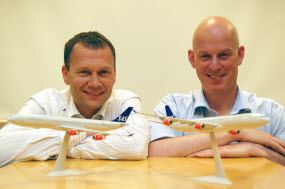
|
|
Business developers Trond Bakken (left) and Hans Erik Swendgaard at SINTEF ICT coordinate SINTEF's work on Air Traffic Management. Photo: Svein Tønseth |
Joint-venture company
Together with Sweden’s SAAB and the Irish Airtel ATN, the Norwegian organisations have recently formed the company NATMIG AS.
The partners in the new alliance will be joining the race to bring forth new technology for air traffic control – an area known internationally as Air Traffic Management (ATM).
Part of the EU’s Framework Research Programme
NATMIG AS, of which the four partners each own 25 percent, has been awarded contracts worth a total of MNOK 324 (€36 million) for the coming eight-year period.
Of the total, at least 38 percent will go to Park Air Systems, which manufactures, landing systems, systems for controlling aircraft movements on the ground and in the air, and other communication systems for the aviation sector. About 34 percent will come to SINTEF – the largest research organisation in Scandinavia.
The client is the publicly- and privately-financed SESAR Joint Undertaking programme, which manages the European Commission’s research funding in the ATM sector.
New air routes
The purpose of SESAR, in a nutshell, is to provide air-traffic controllers with intelligent information system that will deliver aircraft to their destinations more rapidly, even more safely and in a more environmentally friendly manner than they do today. And the level of ambition is high:
The aim is to allocate sir routes that will allow airspace capacity to be trebled and improve safety by a factor of 10, while reducing the environmental impact of each flight by 10 percent. A further aim is to cut the cost of ATM by 50 percent.
20 minutes faster to Brussels
NATMIG AS offers the Stockholm – Brussels route as an example of what we can realistically expect of the SESAR programme: on this route the future ATM system will be able to reduce flying time by between 12 and 20 minutes, save 435 to 725 kilos of fuel and thus reduce CO2 emissions by between 1370 and 2283 kilos.
SINTEF initiative
The establishment of NATMIG AS (North European ATM Industry Group) is the result of an initiative taken by Vice-president Aage J. Thunem of SINTEF ICT.
NATMIG is one of16 members of SESAR JU, a joint European research programme in which industry actively participates in the design of research and development programmes.
Scandinavian environmental awareness
“NATMIG will bring Scandinavian environmental awareness into SESAR. We will also make sure that regional requirements and challenges in this region are taken into account,” says Thunem, who is chairman of the board of NATMIG.
|
By Svein Tønseth |
Contacts
SINTEF:
Special consultant Hans Erik Swendgaard, SINTEF ICT. Tel: +47 934 59 103
